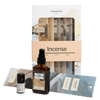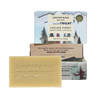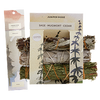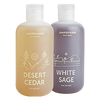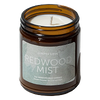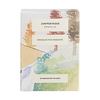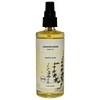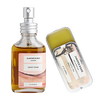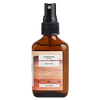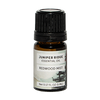
Jalama is a line of naturally dyed home goods and accessories, with clothing currently in the works. All of the dyes we use are found commonly in California, with the acceptation of indigo for special projects such as this.
While many dyeable plants are fruits and vegetables, the plant dyes that we use the most are plants that are invasive or do not have valuable use as food.
What method do you use? Can you describe the process?
The methods I use vary depending on the material that I am dyeing and which dye is being used so its difficult to be specific.
Generally fiber is first prepared with a mordant ( usually a metallic substance that acts as a fixative for dye) before it is immersed in a dye bath. Most plant based dye baths are made by finely cutting up the plant material that is then steeped in water and strained. One of my favorite parts of working with plants is the straining process for fragrant dyes like eucalyptus and sagebrush, you get a nice aromatherapy steam facial every time!
Can you speak about what drew you to this method of dying? What keeps you intrigued?
Plants and nature in general have always been my primary source of inspiration and interest, and so using natural dyes as opposed to synthetic is partly about its impact on the environment, a love for plants and my own personal health. I started out by working with synthetic dyes but after enough time dumping dye baths down the drain and staining my skin I knew it was harming the environment and myself so I deliberately switched to natural dyes as a healthier alternative.
I am so glad that I did because using natural dyes has so many interesting components to it and plants are so fascinting it is hard not to be constantly intrigued! The plants all have such different personalities. Their color can vary greatly depending on the season and where they are harvested from. Its what keeps me intrestest but is also a big challenge as far as consistency goes. Often dye baths turn out differently than expected or hardly at all, even if you did the same thing many times before.
Were you formally trained and who influenced you? Who were your mentors?
I don’t have any formal training in natural dyes other than attending one workshop years ago, and another very specified mushroom and lichen dye class. My love for dyeing started very young when my musician mother took me to this camp out music festival where I would spend most of my time at the tie dye craft booth, and over the years learned a lot of techniques.
Later in art school I incorporated dye into some of my pieces and worked for a shibori/dye based clothing line before deciding to work with natural dyes and move back to California.
What are your top three favorite plants to use right now and why?
My all time favorite would have to be sagebrush, it just smells amazing, is delightful to harvest and is one of the most consistent in its color.
Cochineal is so fascinating to me because of the range of color that you can get with it, its potency, and its long history as an important dye. It is the most difficult to harvest because I usually pick off/scrape the bugs and use them fresh as opposed to getting it dried. They are like little gems that make some of the most brilliant red to purple colors.
Lately I have been loving acorns most of all! The color I have been getting is very similar to eucalyptus but a bit more vibrant. What I love most about acorns is the act of collecting them, you look and look and then once you find one you suddenly see many!
Doing smaller items and larger scale things that are very weighty are pretty different? What was it like to handle these bigger pieces of fabric?
This was definitely the most difficult and physical dye project I have ever taken on. Not only does dyeing sheets require extremely large dye baths, but especially with a material like hemp the duvets become extremely heavy when wet.
The shibori process used on some of the sheets required two people to fold and the resists techniques required large pieces of wood and took a much more sculptural approach than something like a shirt would.
Where do you get your raw materials? Are they hard to obtain? Specifically, what materials did you use for this project with Juniper Ridge and Gold Dust Collective?
Some plants/dyes are more difficult to obtain than others, eucalyptus being the easiest and cochineal the most difficult for this specific project.
The Eucalyptus was collected in Marin and the East Bay where eucalyptus trees are bountiful.
The Sagebrush is a combination of Juniper Ridge byproduct and some that I gathered in my hometown Santa Barbara. The cochineal was also collected in Santa Barbara off of a few highly infected plants in my parents neighborhood. Thankfully it is a very potent dye, but was still a lot to obtain for such large pieces!
Indigo dye isn’t one of the plants Jalama typically uses because it is not naturally occurring in California, but because it is pretty popular now plants can be found online and pre-reduced indigo is widely available.
There seems to be a resurgence in using natural materials for dyeing. Why do you think that is?
It seems there has been a resurgence in going back to old methods of making and homesteading because of the general lack of integrity in modern consumerism. People like to feel connected to their things, however with so much of our stuff coming from anonymous factories with questionable moral and environmental practices it is hard to do that.
Collecting and using natural materials for dye tunes you back in to understanding the magic and alchemy available to us in nature, a much more rewarding feeling than emptying some chemical powder out of a plastic container bought at a store.
We spend 1/3 of our lives in bed, it seems important to consider what we’re sleeping on. How is this bedding different than the bedding you could get in bigger box stores?
To start with, the hemp that Jungmaven uses is such a wonderful material. It is durable yet similar to linen and increases in softness the more its washed. Hemp requires much less water than other textile crops and no pesticides which makes it a much more sustainable alternative to cotton. That combined with the lack of chemicals in the natural dye process make them healthier for you and for the environment. Also the sage and eucalyptus have such a wonderful smell for a couple washes, and its hard to find that in a big box store.
Any books/resources you would recommend for folks interested in learning more?
There are a lot of natural dye books out there, but The Modern Natural Dyer by Kristine Vejar is good and has beautiful and inspiring photography styled by a wonderful talented woman that I know.
Fibershed is something that anyone interested in sustainable textiles should learn about.
Later this fall and winter Jalama will be teaching more workshops at our new studio location, so stay tuned for those on our social media if interested in learning more about natural dyes!

